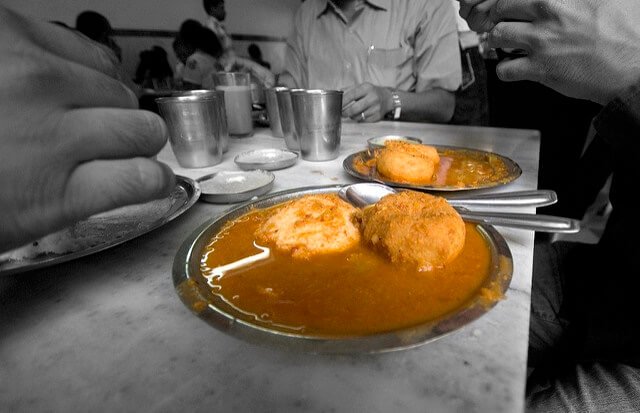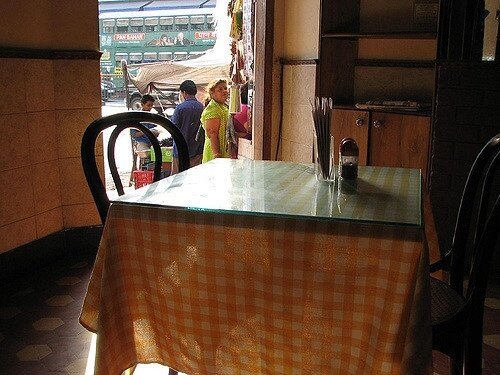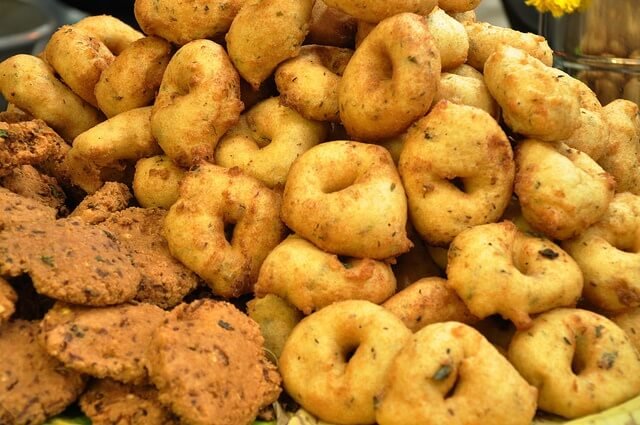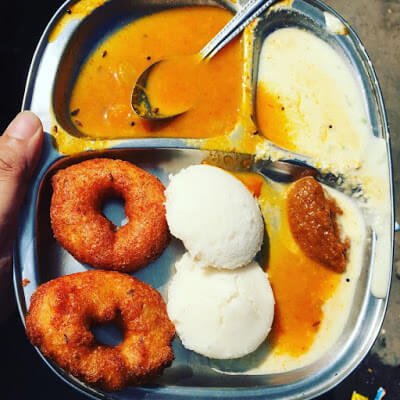A common sight on the streets of Mumbai is that of men cycling with a couple of aluminum cans strapped to their cycles. You see them at all times of the day. Early in the morning, way past midnight, through the day.
Sometimes you see them parked on a street corner with a bunch of people surrounding them. The crowd cuts across all demographics. Men and women. You could have a mutual fund money manager rubbing shoulders with the watchman from the same complex. These cycles are great levelers.
They sell hot chai, cigarettes at times. Food too. Usually South Indian snacks of deep-fried medu vadas and steamed idlis. These work as breakfast options for Mumbai’s busy bees who might not have had breakfast before they set off for work. The cycle vendors station themselves near office complexes in the morning. In the evenings, you can find them parked near train stations waiting for folks who are headed home.

My first medu vada experience in Mumbai was from a cycle cart. In fact, most people that I see gathered around these cycles seem to make a beeline for the medu vadas. There is something reassuring about biting into a carby, deep-fried treat, in the middle of a busy day, with some tongue tickling coconut chutney to liven things up.
When one thinks of Mumbai and its street food, what comes to mind are the vada pavs. Batata vadas (potato patties) stuffed in soft, Portuguese-originated pavs. Batata vadas have been a staple of the Maharashtrian household for ages, and the popularity of vada pavs is ubiquitous through Mumbai. However, medu vadas can also claim to be a part of the Mumbai’s menu today.
Apart from the cycle carts, you will find them in the breakfast buffets of the city’s five star hotels and the ever-packed Udupi joints that dot the city. The Udupi places are run by Mangaloreans and dominated the city’s restaurant scene when the Irani Cafes began to lose steam.

The Mangaloreans were quick to step in with their Udupi vegetarian joints and seafood heavy Shetty lunch homes. While you will find the traditional Udupi restaurants in Matunga and Fort, you will find newer Udupi joints across the rest of Mumbai. The further they are from Matunga, the more likely they are to offer Schezwan and Mexican dosas, both with a liberal dose of cheese.
Medu vadas and idlis feature on Udupi restaurant menus of course. The suburban Udupi joints, especially the ones in areas such as Bandra West, Juhu and Lokhandwala offer vadas and idlis that are more expensive than the ones in Matunga. They are bigger in size too. Often the taste doesn’t live up to the grand size and you miss the flavour intensity and textural balance of the medu vadas and idlis of the cycle carts or of the old school Udupi joints here.
My favourite place for medu vadas and idlis in the suburbs is at a tiny shack opposite the Guru Nanak Hospital. It is called Sai Balaji. It is open from 8 am till about 3 pm. The owners of the store are not Mangalorean, unlike in the case of the Udupi restaurants. They are Tamils, as the calendar with the picture of politician Jayalalitha at the stall will tell you.
The stall is run by a husband and wife duo, Gomati and her husband Pandyan. They came to Mumbai from Kovilpatti in Tamil Nadu about two decades back. They set up the dosa shack a decade back.
Every morning you will see Pandyan frying medu vadas and dal vadas and serving them fresh from the kadai to his hungry customers. Gomati takes out the batter, which she hand-whipped herself earlier, and steams idlis through the day. The vadas and idlis are smaller than what you get in local Udupi restaurants and taste way better and fresher.
In between steaming idlis, Gomati makes fresh batches of sambar when Pandyan is not using the kadai. Unlike in Mumbai’s suburban Udupi joints, her sambar is not sweet. It is savoury, tangy and has a delightful chilli kick to it. She also makes a chutney with tomato, onions and dried red chillis in her kadai, apart from the more common white coconut chutney.

Everything is made fresh here. When the crowd is a bit less in the afternoons, they make dosas too. The dosas are softer and chubbier than the crisp and thin Udupi restaurant dosas.
Gomati and Pandyan’s story is another of my favourite tales which symbolises why Mumbai is the city where dreams come true.
The story of a Tamil immigrant couple who came to Mumbai to seek their fortunes. They moved into Bandra East. A quiet, very green, residential, Maharashtrian-dominated area, a world far removed from the more hip and cosmopolitan Bandra West. Bandra East at one time was centred around Kala Nagar, a residential society set up by the state government for local artists. After a decade of trying out different things, Gomati and Pandyan opened their stall and sold their native South Indian – specifically Tamil – snacks.

Their initial customers were local Maharashtrians. Then a few modern office complexes opened nearby and suddenly business multiplied for the Balaji stall owners. Their clientele represented the many communities that have made Mumbai their home. Joining the local Maharashtrians were Gujaratis and Rajasthanis from the west and North Indians from Punjab, Uttar Pradesh and Rajasthan and Bengalis, Biharis, Odiyas from the east, Tamilians and others from the South too. All gathered together for some good food – and those medu vadas.
It is this eclectic spirit, that has made the medu vada as much a part of Mumbai as the local batata vada.
Note: A plate of 3 medu vadas/ idlis or a combination, costs Rs 30 at the Balaji Stall. Do specify if you want your sambar served separately. There is no seating here. You stand and eat or take away parcels. My advice is to try to eat the food while its fresh and hot.

















